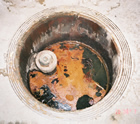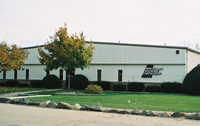Manufacturing Properties

Horizontal milling machine at a manufacturing property
A manufacturing property includes all lands, buildings and structures used in the manufacturing process. Examples are machine shops, metals stamping facilities, foundries, electroplating shops and various assembly plants. Manufacturing properties may be located in older areas of communities or in newer industrial parks.
Manufacturers are constantly looking for ways to make their products cheaper and faster. As manufacturing processes have become more efficient, the materials used and the wastes generated have changed. Therefore, a significant amount of time may be spent in a Phase 1 ESA researching the past and present manufacturing processes used at a facility and how waste management practices changed over time.
Common environmental concerns at manufacturing properties

Leaking catch basin
- Solvents and oils stored in barrels on grassland or gravel-paved areas
- Oil and petroleum product spillage
- Leaking catch basins
- On-site disposal of wastes
- Leaking underground fuel oil tanks and spillage near the tank fill pipes
- Leaking underground gasoline and diesel fuel tanks
- Improper management of hazardous wastes
Project Spotlight Prefinished Millwork Corporation, University Avenue, Middleton, WI

A Phase 1 ESA of this manufacturing property in Dane County, Wisconsin determined that Prefinished Millwork Corporation produced interior wood trim products in a production building at the property from 1979 to 2007. Wood coatings consisting of a mixture of stains and solvents were prepared in the production building’s paint room. Any materials spilled in the paint room went down a drain and into an underground steel holding tank. A French drain (draining directly into the soil) was also in the concrete floor in the production building. Based on this information, the Phase 1 ESA stated that soil samples should be collected 1) under the holding tank from the paint room, 2) from the sediment at the bottom of the French drain, and 3) from the soil beneath the sediment in the French drain and that all of the samples should be analyzed for volatile organic compounds.